
Photo by Regina Willette
The Portable Office: A Peek into a Midwife’s Homebirth Bag
Editor’s note: This article first appeared in Midwifery Today, Issue 126, Summer 2018.
Subscribe to Midwifery Today Magazine
The birth bag becomes a constant companion over the years. A midwife becomes attached to its familiarity and it can be an anchor and helper in a precipitous delivery or an emergency. The watchword is “be prepared.” You want to have everything you might need for any eventuality—from the baby arriving before you do, to being at a home for 48 hours, to having back-to-back births, to transports.
The Birthkit
The birth bag is only one of five components of the total birth “kit,” which also includes oxygen and its accoutrements¹, the prenatal bag (see “The Portable Office: The Homebirth Midwife’s Prenatal Bag, Midwifery Today, Issue 124, Winter 2017), the car, and the back-up/emergency box (see “The Homebirth Midwife’s Portable Office: Her Car,” Midwifery Today, Issue 122, Summer 2017). To be totally prepared, the midwife must have all the components in place at all times and bring each one to births (including the prenatal bag, because it contains some items you will need, such as a Doppler and/or fetoscope, blood pressure cuff, etc.).
The Birth Bag Itself
Contents of a particular midwife’s birth bag will vary according to her practice. It will depend on whether she is urban or rural; the distance to hospital and EMS; community standards of care; the midwife’s experience, training, and legal status; state laws; and her personal protocols and preferences (every midwife has her favorite tools). (See Anne Frye’s book Holistic Midwifery: A Comprehensive Textbook for Midwives in Homebirth Practice: Volume II (2013) and ACNM’s The Home Birth Practice Manual for more suggestions of items to carry in your bag—given the limits of space and what you can lift.)
The birth bag should be light but sturdy, and washable. (For more hints on types of bags and packing them, see “The Well-Organized Birthkit,” Midwifery Today, Issue 93, Spring 2010.) My current favorite is a simple gym bag bought on sale for less than $15 at a chain grocery store. The compartment made for smelly gym shoes nicely fits all my emergency resuscitation equipment so it is handily available in one spot. The other side compartment is for personal things, so they can be separate from the birth supplies. Small items go in the pockets in the front flap. Larger things go in the big main section. Be sure everything is easy to get to, with the items used most and emergency equipment readily available on top or in their own special section(s). It helps to have things you will use together, organized in clear plastic bags or different-colored bags.
Each midwife needs to decide on the answer to the dilemma of how to have the birth bag available when needed. If possible, it is best to have two bags, in case you are too tired after a long birth to replace everything immediately. You never know when the next one is coming! It may happen that someone else calls you to her labor just after you have fallen exhausted into bed. Some midwives carry their birth bag with them everywhere they go when on call. This can be problematic if the temperature is below freezing or the bag is locked in a hot car. Medications, herbs, test strips, plastics, and other components can be damaged by being kept outside their optimal temperature ranges. It is very inconvenient to lug the bag inside with you wherever you go, and not at all practical in stores or other public places. If you have a small practice without many overlapping due dates, you may want to leave a birth bag at each home near the end of pregnancy. This is very helpful for the birth assistant if she arrives before you do, so she can start assessments and setup. If the baby comes before you arrive, she will have all the supplies she needs to assist the birth herself.
Tools of the Trade
Contents of the birth bag will also vary depending on what the midwife has asked the clients to provide for the birth. It is usual for a family to provide at least sheets, towels, pads, and some other disposables. However, some midwives will bring everything needed. Others ask clients to purchase a personalized birth kit from a midwifery supply company. Some may require the client to obtain almost everything, including gloves, medications, herbs, baby scale, etc. Nonetheless, the midwife needs to bring extra in case the client has failed to procure what was assigned to her and, occasionally, during a long labor, her supplies may run out. If an emergency transport is required, it is also nice to know that you “have it in the bag” and grab it quickly to bring on transport. It’s a good idea to check the family’s supplies at the “rehearsal” home visit in late pregnancy to be sure she has everything and that it is the right size.
It may be helpful to place things in your bag by category as follows:
Paperwork. The client’s chart if using paper; or laptop, iPad, or phone, if using electronic records. Don’t forget the chargers. Extra blank forms for labor and delivery, postpartum, newborn exam, and transfers. Copy of birth bag contents for easier replacement after the birth.
Disposables. Chux or other underpads, sterile 4″ x 4″ gauze pads, lubricant (sterile and nonsterile), cord clamps, sterile field, urinary catheter, nitrazine paper, gloves (sterile and nonsterile).
Instruments/Tools. Episiotomy scissors, suture scissors, umbilical scissors, tissue forceps, long and short needle holders, forceps, sponge (ring) forceps, nail brush for washing instruments, and a set of sterilized instruments containing at least two forceps and one scissor; oto/ophthalmoscope, pulse oximeter, extra Doppler, blood pressure cuff (if you have one).
Medications/Herbs/Repairs, etc. Pitocin, Methergine, Cytotec², erythromycin eye ointment, lidocaine, vitamin K, smelling salts, shepherds’ purse, peppermint, cotton root bark, blue and black cohosh, Placenta Ease, tape, butterfly needles, alcohol prep pads, needles, syringes, sutures, Band-Aids, vacutainer tubes, cotton swabs, culturettes, amnihooks.
Liquids (all in plastic bags). Doppler gel, alcohol, Betadine, hydrogen peroxide.
Emergency equipment. IV setup and fluids; infant resuscitation kit, including bag and mask; suction and accoutrements (e.g., Res-Q-Vac and DeLee), stethoscope, “space” blanket.
Infant supplies. Bulb syringe, extra newborn hat, measuring tape, hanging scale, sling.
Personal items. Toothbrush and toothpaste, dental floss, hairbrush/comb, small pack of tissues, menstrual supplies, extra socks, bra and underpants, nail clippers/cleaners, hand sanitizer, delivery outfit, possibly some energy food, any special needs such as extra glasses, meds, etc.
Miscellaneous. Headlight with good batteries, extra batteries of all sizes for equipment, pens, pencil, thermometer usable for both mom and babe, sterile specimen cup, if needed for suturing/washing, two extra garbage bags rolled up tightly.
Organization is important! Find the most efficient way to pack your birth bag and always keep each item in the same spot so you can retrieve it instantly and notice after the birth if it needs to be replaced. Each birth bag is unique and fitted to the needs of the individual midwife, her tools, and the bag. Treat your birth bag well and it will treat you well. Enjoy!
Notes:
- We assume that birth attendants are conversant with the strong recommendation to use room air instead of oxygen for the initial resuscitation of depressed newborns. If, after establishing effective ventilations and heart compressions, there is still central cyanosis, then supplemental oxygen may be considered. Supplemental oxygen should be given with an air/oxygen blender (one tank of oxygen, one tank of compressed air) and pulse oximeter. Per International Liaison Committee on Resuscitation (ILCOR): “The need for resuscitation at birth in planned home deliveries is rare. Most midwives use air via bag-valve systems for mask inflation at home. The absence of additional oxygen is unlikely to be of any consequence in this situation.”
- Cytotec/misoprostol should never be used for induction of labor due to risk of hyperstimulation of the uterus and other adverse effects.
References:
- Willette, R. 2010.” The Well-Organized Birthkit.” Midwifery Today 93: 12–14.
- ———. 2017. “The Homebirth Midwife’s Portable Office: Her Car!” Midwifery Today 122: 44–45.
- ———. 2017. “The Portable Office: The Homebirth Midwife’s Prenatal Bag.” Midwifery Today 124: 30–31.
- Frye, Anne. 2013. Holistic Midwifery, Volume II. Portland, Oregon: Labrys Press.
- Bailes, Alice, Ed. 2016. The Home Birth Practice Manual, 3rd Ed. Silver Spring, Maryland: American College of Nurse Midwifery.





















